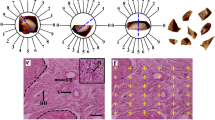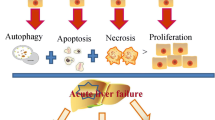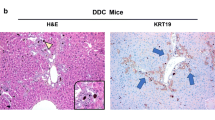Abstract
Background
Injecting MSCs via blood vessel is most commonly used method, which has a major drawback of safety. The aim of our study was to evaluate efficacy using scaffold-loaded MSCs in acute liver failure model.
Method
Acute liver failure was induced in mice using thioacetamide (TAA) (200 mg/kg, i.p) once a day for two consecutive days. The animals were divided in four acute liver failure groups: (1) TAA; (2) empty scaffold; (3) MSCs injected through tail vein; (4) MSC + Scaffold, scaffold loaded with MSCs, to evaluate the mortality and changes in liver function. Polylactic-co-glycolic acid scaffold alone and loaded with human MSCs was implanted on mice dorsum.
Results
TAA dose was titrated until one-third mortality rate was achieved. TAA (200 mg/kg) once daily for two consecutive days was injected to establish the acute liver failure model. The mortality of TAA and scaffold groups was 55.9% and 63.2%, respectively. Although, mortality of MSC-TV group decreased 14.7% as compared to TAA group (p = 0.200), MSC + Scaffold group had the lowest mortality (31.4%) (p = 0.013). Cells implanted in PLGA biomaterial were survived until 3 weeks, and their function was increased. Area of hepatic inflammation and necrosis was significantly reduced in MSC-TV and MSC + Scaffold groups; but there was no difference between the two groups. Gene expressions related to inflammation were significantly decreased in MSC-TV and MSC + Scaffold groups compared to TAA group. In MSC + Scaffold group, no migration of stem cells to liver tissue was observed. Although, not all cells in scaffold were stained, some of them were differentiated into hepatocyte-like cells which stained positive for PAS and CYP2E1 antibody.
Conclusion
Scaffold loaded with MSCs showed protective effects via paracrine signaling on acute liver failure model.





Similar content being viewed by others
Abbreviations
- ALB:
-
Albumin
- ALF:
-
Acute liver failure
- ALT:
-
Alanine aminotransferase
- AST:
-
Aspartate aminotransferase
- FGF:
-
Fibroblast growth factor
- GAPDH:
-
Glyceraldehydes-3-phosphate dehydrogenase
- HGF:
-
Hepatocyte growth factor
- INR:
-
International normalized ratio
- MELD:
-
Model for end-stage liver disease
- MSC:
-
Mesenchymal stem cell
- PLGA:
-
Polylactic-co-glycolic acid
- PT:
-
Prothrombin time
- TAA:
-
Thioacetamide
- TBIL:
-
Total bilirubin
- VEGF:
-
Vascular endothelial growth factor
- TNF:
-
Tumor necrosis factor
- MCP:
-
Monocyte chemoattractant protein
- NLRP:
-
NACHT, LRR, and PYD domains-containing protein
- ASC:
-
Apoptosis-associated speck-like protein containing carboxy-terminal CARD
References
Mark AL, Sun Z, Warren DS, et al. Stem cell mobilization is life saving in an animal model of acute liver failure. Ann Surg. 2010;252:591–596.
Ren X, Hogaboam C, Carpenter A, Colletti L. Stem cell factor restores hepatocyte proliferation in IL-6 knockout mice following 70% hepatectomy. J Clin Investig. 2003;112:1407–1418.
Khan AA, Parveen N, Mahaboob VS, et al. Safety and efficacy of autologous bone marrow stem cell transplantation through hepatic artery for the treatment of chronic liver failure: a preliminary study. Transplant Proc. 2012;2008:1140–1144.
Takami T, Terai S, Sakaida I. Stem cell therapy in chronic liver disease. Curr Opin Gastroenterol. 2012;28:203–208.
Kharaziha P, Hellstrom PM, Noorinayer B, et al. Improvement of liver function in liver cirrhosis patients after autologous mesenchymal stem cell injection: a phase I–II clinical trial. Eur J Gastroenterol Hepatol. 2009;21:1199–1205.
Suk KT, Yoon JH, Kim MY, et al. Transplantation with autologous bone marrow-derived mesenchymal stem cells for alcoholic cirrhosis: phase 2 trial. Hepatology. 2016;64:2185–2197.
Jang YO, Kim YJ, Baik SK, et al. Histological improvement following administration of autologous bone marrow-derived mesenchymal stem cells for alcoholic cirrhosis: a pilot study. Liver Int. 2014;34:33–41.
Xue R, Meng QH, Dong JL, et al. Clinical performance of stem cell therapy in patients with acute-on-chronic liver failure: a systematic review and meta-analysis. J Transl Med. 2018;16:126.
Kim G, Eom YW, Baik SK, et al. Therapeutic effects of mesenchymal stem cells for patients with chronic liver diseases: systematic review and meta-analysis. J Korean Med Sci. 2015;30:1405–1415.
Peng L, Xie DY, Lin BL, et al. Autologous bone marrow mesenchymal stem cell transplantation in liver failure patients caused by hepatitis b: short-term and long-term outcomes. Hepatology. 2011;54:820–828.
Jung Y, Bauer G, Nolta JA. Concise review: Induced pluripotent stem cell-derived mesenchymal stem cells: progress toward safe clinical products. Stem Cells. 2012;30:42–47.
Gnecchi M, Zhang Z, Ni A, Dzau VJ. Paracrine mechanisms in adult stem cell signaling and therapy. Circ Res. 2008;103:1204–1219.
Tang YL, Zhao Q, Qin X, et al. Paracrine action enhances the effects of autologous mesenchymal stem cell transplantation on vascular regeneration in rat model of myocardial infarction. Ann Thorac Surg. 2005;80:229–236. (discussion 236–237).
Ratajczak MZ, Kucia M, Jadczyk T, et al. Pivotal role of paracrine effects in stem cell therapies in regenerative medicine: can we translate stem cell-secreted paracrine factors and microvesicles into better therapeutic strategies? Leukemia. 2012;26:1166–1173.
Timmers L, Lim SK, Arslan F, et al. Reduction of myocardial infarct size by human mesenchymal stem cell conditioned medium. Stem Cell Res. 2007;1:129–137.
Timmers L, Lim SK, Hoefer IE, et al. Human mesenchymal stem cell-conditioned medium improves cardiac function following myocardial infarction. Stem Cell Res. 2011;6:206–214.
Walter MN, Wright KT, Fuller HR, MacNeil S, Johnson WE. Mesenchymal stem cell-conditioned medium accelerates skin wound healing: an in vitro study of fibroblast and keratinocyte scratch assays. Exp Cell Res. 2010;316:1271–1281.
Shin H, Jo S, Mikos AG. Biomimetic materials for tissue engineering. Biomaterials. 2003;24:4353–4364.
Vats A, Tolley NS, Polak JM, Gough JE. Scaffolds and biomaterials for tissue engineering: a review of clinical applications. Clin Otolaryngol Allied Sci. 2003;28:165–172.
Shoichet MS. Polymer scaffolds for biomaterials applications. Macromolecules. 2010;43:581–591.
Shimizu T, Yamato M, Kikuchi A, Okano T. Cell sheet engineering for myocardial tissue reconstruction. Biomaterials. 2003;24:2309–2316.
Godier-Furnemont AF, Martens TP, Koeckert MS, et al. Composite scaffold provides a cell delivery platform for cardiovascular repair. Proc Natl Acad Sci USA. 2011;108:7974–7979.
Dvir-Ginzberg M, Gamlieli-Bonshtein I, Agbaria R, Cohen S. Liver tissue engineering within alginate scaffolds: effects of cell-seeding density on hepatocyte viability, morphology, and function. Tissue Eng. 2003;9:757–766.
Zhang SC, Chen L, Liu T, et al. Human umbilical cord matrix stem cells efficiently rescue acute liver failure through paracrine effects rather than hepatic differentiation. Tissue Eng Part A. 2012;18:1352–1364.
Subramanian A, Krishnan UM, Sethuraman S. Development of biomaterial scaffold for nerve tissue engineering: biomaterial mediated neural regeneration. J Biomed Sci. 2009;16:108.
Cooke MJ, Vulic K, Shoichet MS. Design of biomaterials to enhance stem cell survival when transplanted into the damaged central nervous system. Soft Matter. 2010;6:4988–4998.
Li XW, Katsanevakis E, Liu XY, Zhang N, Wen XJ. Engineering neural stem cell fates with hydrogel design for central nervous system regeneration. Prog Polym Sci. 2012;37:1105–1129.
Sahab Negah S, Khaksar Z, Aligholi H, et al. Enhancement of neural stem cell survival, proliferation, migration, and differentiation in a novel self-assembly peptide nanofibber scaffold. Mol Neurobiol. 2016;54:8050–8062.
Li X, Tzeng SY, Liu X, et al. Nanoparticle-mediated transcriptional modification enhances neuronal differentiation of human neural stem cells following transplantation in rat brain. Biomaterials. 2016;84:157–166.
Levenberg S, Huang NF, Lavik E, Rogers AB, Itskovitz-Eldor J, Langer R. Differentiation of human embryonic stem cells on three-dimensional polymer scaffolds. Proc Natl Acad Sci USA. 2003;100:12741–12746.
Li N, Zhang Q, Gao S, et al. Three-dimensional graphene foam as a biocompatible and conductive scaffold for neural stem cells. Sci Rep. 2013;3:1604.
Qi CX, Yan XJ, Huang CY, Melerzanov A, Du YA. Biomaterials as carrier, barrier and reactor for cell-based regenerative medicine. Protein Cell. 2015;6:638–653.
Kyriakides TR, Zhu YH, Yang Z, Huynh G, Bornstein P. Altered extracellular matrix remodeling and angiogenesis in sponge granulomas of thrombospondin 2-null mice. Am J Pathol. 2001;159:1255–1262.
Wintermantel E, Cima L, Schloo B, Langer R. Angiopolarity of cell carriers: directional angiogenesis in resorbable liver cell transplantation devices. EXS. 1992;61:331–334.
Cheung HY, Lau KT, Lu TP, Hui D. A critical review on polymer-based bio-engineered materials for scaffold development. Compos Part B Eng. 2007;38:291–300.
Drury JL, Mooney DJ. Hydrogels for tissue engineering: scaffold design variables and applications. Biomaterials. 2003;24:4337–4351.
Semino CE, Merok JR, Crane GG, Panagiotakos G, Zhang S. Functional differentiation of hepatocyte-like spheroid structures from putative liver progenitor cells in three-dimensional peptide scaffolds. Differentiation. 2003;71:262–270.
Li J, Tao R, Wu W, et al. 3D PLGA scaffolds improve differentiation and function of bone marrow mesenchymal stem cell-derived hepatocytes. Stem Cells Dev. 2010;19:1427–1436.
Kazemnejad S, Allameh A, Soleimani M, et al. Biochemical and molecular characterization of hepatocyte-like cells derived from human bone marrow mesenchymal stem cells on a novel three-dimensional biocompatible nanofibrous scaffold. J Gastroenterol Hepatol. 2009;24:278–287.
Schinkothe T, Bloch W, Schmidt A. In vitro secreting profile of human mesenchymal stem cells. Stem Cells Dev. 2008;17:199–206.
Ohnishi S, Sumiyoshi H, Kitamura S, Nagaya N. Mesenchymal stem cells attenuate cardiac fibroblast proliferation and collagen synthesis through paracrine actions. Febs Lett. 2007;581:3961–3966.
Acknowledgments
This research was supported by Basic Science Research Program through the National Research Foundation of Korea (NRF) funded by the Ministry of Education (NRF-2015R1D1A1A02061717).
Author information
Authors and Affiliations
Contributions
DWJ and JHL contributed to study design and grant; JSL, HTK, and YJC did animal care and analyzed the data; HTK wrote the manuscript, WKS assisted with English language use; and KJ interpreted histological finding.
Corresponding authors
Ethics declarations
Conflict of interest
The authors declare that they have no conflict of interest.
Guarantor of the article
Dae Won Jun.
Electronic supplementary material
Below is the link to the electronic supplementary material.
10620_2018_5363_MOESM1_ESM.tif
Supplementary Figure 1. Mesenchymal stem cells (5x105) were stained for flow cytometry and analyzed using FACS CANTO II (Becton–Dickinson & Co., San Jose, CA) using CD73, CD90, CD105 antibody as stem cell surface marker. (A) Co-stain with CD90 and CD105 antibody, 99.9% of stem cells were positively expressed. (B) Co-stain with CD73 and CD90 antibody, 99.9% of stem cells were positively expressed. (C) Co-stain with CD73 and CD105 antibody, 100% of stem cells were positively expressed. (TIFF 2865 kb)
10620_2018_5363_MOESM2_ESM.tif
Supplementary Figure 2. AST and ALT levels of each groups. At first, all groups had high level of AST and ALT and as time goes on to the third day, AST and ALT level were naturally decreased but they were more decreased in MSC + Scaffold group compared to control group. AST and ALT data were given as the mean ± SEM with one-way ANOVA test with Tukey’s multiple comparisons test by GraphPad Prism7 (p = 0.01 to 0.05: *, p = 0.001 to 0.01: **, p = 0.0001 to 0.001: ***, p < 0.0001: ****) (TIFF 1814 kb)
Rights and permissions
About this article
Cite this article
Kang, H.T., Jun, D.W., Jang, K. et al. Effect of Stem Cell Treatment on Acute Liver Failure Model Using Scaffold. Dig Dis Sci 64, 781–791 (2019). https://doi.org/10.1007/s10620-018-5363-2
Received:
Accepted:
Published:
Issue Date:
DOI: https://doi.org/10.1007/s10620-018-5363-2




